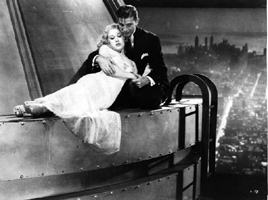

USA action
1933
bw 101 min.
CAV: $74.95 - available
2 discs, catalog # CC0102L
CLV: $39.95 - available
1 disc, catalog # CC1116LK

King Kong is unique in motion picture history. In the 51 years since its original release,
its particular combination of unbridled imagination and ingenious
craftsmanship has never been equalled. Not only has it stood the test of time, but King Kong
has influenced several generations of writers and filmmakers, including Ray Harryhausen, Ray Bradbury,
Steven Spielberg and George Lucas.
King Kong is a work of genius -- actually three geniuses: Merian C. Cooper, whose
brainchild it was;
Willis O'Brien, who created and supervised the film's unsurpassed special effects; and Max
Steiner, whose scoring of the picture was a landmark, setting new standards for the use of music in motion
pictures. Kong is a testament not only to their abilities, but also to the virtues of
the much-maligned studio system as a catalytic creative unit. In the half-century since Kong
first climbed
the Empire State Building into the collective subconscious of moviegoers the world over, the
film has become the subject of controversy and intense critical analysis.
Bosley Crowther, long the dean of American film critics, wrote that it has "implication more
profound than
had ever before been generated in a mere monsster or science fiction film." Kong is far
more than "a mere monster or science fiction film." It is a fantasy adventure romance of spectacular
proportions, a 20th century version of the Beauty and the Beast legend and an allegory on the
destructive
powers of both love and civilization.
Serious discussion was given to various theories: that the film was unconsciously racist; that
it was an
outsized sexual fantasy with elaborate analogies explaining Kong's climbing the Empire State
Building as a blatant form of phallic symbolism. The French surrealists saw it as a pristine example of
"L'amour fou," mad or doomed love. Cooper, its creator, was alternately amused and disgustedd
by these theories, maintaining to the end of his life that Kong "was never intended to be
anything
but the best damned adventure film ever made, which it is; and that's all it is."
However, there is a common agreement between both its fans and its detractors: King Kong
is among the most watchable American movies ever made. It picks the spectator up and -- with sheer
technical bravura and unmatched narrative excitement -- plunges headlong into a world that only the movies
could create: mysterious, suspenseful, thrilling and wonder-inducing. Konng is the fastest
101 minutes on celluloid, and while its love story and some of its staging may seem quaint by today's
standards, there is no denying the breathless pacing and the relentless energy with which the story
unfolds.
The world premiere of King Kong took place on Thursday, March 2, 1933 at both the new Radio
City Music Hall and the new RKO Roxy Theatre. The durability of Kong was proven over the years
by numerous reissues. It was one of the first films to be truly "brought back by popular demand,"
although for the 1938 revival, the Production Code Administration, which had not been in existence in 1933,
forced RKO to eliminate some of Kong's more violent and provocative actions. Gone were the
stomping and chewing of humans; his methodical peeling off of Fay Wray's clothes; and his callous
disposal of the "wrong" woman in New York. These deletions completely changed the tenor and
complexity of the characterization of Kong, giving him a softer, safer quality, removing the graphic,
nightmarish aspects of his gleeful mutilation and sometimes casual destruction of individuals.
It was also during the period of these theatrical reissues that the film lost some of its
visual luster, as the image was darkened considerably through improper negative handling
and laboratory printing inaccuracies, resulting in a substantial loss of detail.
The sequences deleted in 1938 restored in 1969, with restored footage all coming from 16mm
prints, so there is considerable difference in both image and sound quality between these scenes and the
rest of the film.
Criterion has utilized every possible form of electronic enhancement techniques to eliminate scratches,
spots and other abrasions inherent in the material. Thus we are confident that even the most critical eye
will agree that this edition of King Kong restores it to its rightful place as one
of the visual masterpieces of the 1930s. This makes it possible for all to see,
as never before, the imagination and craftsmanship of Cooper and his co-workers, who achieved the truly remarkable
feat of turning an 18-inch toy gorilla into one of the mythic figures of 20th-century civilization.
-- Ronald Haver
About the Transfer
For this laserdisc,
Criterion has made use of the best existing material, both negatives and prints of the film.
The bulk of what you will see was derived from a 35mm negative from the Library of Congres. Use
of this negative allowed us to obtain an image that is the equivalent of looking through the camera viewfinder,
and almost every shot in the film was retimed to obtain the sharpest, brightest, crispest image possible.






